Last Reviewed and Updated on February 17, 2023
Prepare to be shocked as some of these strange animals look otherworldly or like something that shouldn’t really exist. This list of the 100 weirdest animals in the world will have your jaw drop as you explore unusual species, from deers with vampire-like fangs, through fully or partially transparent animals to animals without organs.

100 Weirdest Animals in the World
This list of the weirdest animals in the world only scratches the surface; there are many more fascinating, unusual, strange looking animals out there. This list also doesn’t include microscopic organisms that are also more than capable of blowing one’s mind (looking at you, tardigrades). Some animals made this list due to their strange looks, and others due to their unusual characteristics.
You might also like: 100 weirdest facts about animals you won’t believe are true
1. Tufted Deer

Kicking of this list of 100 strangest animals in the world is a deer species straight out of nightmares that was peculiarly named for the tuft on its head and not for its vampire fangs.
Males of this species have notable fang-like canine teeth but don’t worry; these animals are herbivores like other deer. They also aren’t the only deer species with terrifying fangs; Chinese water deer and a couple of others have similar canine teeth.
2. Coconut Crab

Gigantic crabs that eat everything they can get their hands (prawns) on and are capable of climbing trees?
Be sure to go through our list of coconut crab facts to learn more about this slightly terrifying animal that might even be responsible for why the pioneer pilot Amilia Einhart was never found.
3. Stargazer Fish

There are many fish in the sea, some insanely adorable, others sending shivers down your spine. The stargazer might not be the scariest looking of them all, but it is certainly strange. Stargazers have their eyes on the top of their head. That and their habit of burying themselves in the sand (looking all creepy while at it) makes them great ambush predators.
4. Long Horned Orb Weaver Spider

It would be a miracle if a list of the strangest animals in the world wouldn’t include at least one spider. Meet the long-horned orb weavers, spiders notable for their females that have extremely long, curved spines on their abdomens.
5. Cantor Giant Soft Shell Turtle

A turtle that looks a little deflated? This turtle species has a very smooth carapace. Sadly, it is a critically endangered species that has already disappeared from most of its natural range due to habitat loss.
6. Platypus

Platypus is one of the only two mammals that lay eggs. That in itself makes them strange enough, but the fact they have a duck-like bill and are also venomous helps. In the grand scheme of things, this one right here is one of the top strangest animals in the world.
7. Echidna

Echidna might not look strange at first glance, but since echidnas are one of the two mammals that lay eggs, have a pouch, and are electrosensitive, they deserve their spot on this list.
8. Black Musslecracker

These large fish have grumpy faces.
9. Mangalica Pig

This Hungarian breed of domestic pig is one of the most unique in the world; not only is it the only living pig with a long coat, but its coat also looks very much like a sheep’s.
10. Red Lipped Batfish

Is this a frog wearing lipstick? Nope, just a peculiar-looking fish. One of the strangest looking animals in the sea for sure.
11. Lowland Streaked Tenrec

The most punk-rock tenrec of them all.
12. Blue Sea Slug

These tiny sea slugs have a very otherworldly look.
13. Dragon Lizard (Draco Volans)

If anyone ever says dragons are not real, show them dragon lizards. This species, known as the common flying dragon, has “wings” and is capable of gliding or parachuting through the air.
14. Lungfish

Lungfish are one of the strangest animals in the world, hands down. As their name suggests, these fish have lungs and can breathe air. Not only are they capable of breathing air, but all but one species of lungfish need to breathe air from the surface and can’t get enough oxygen through their gills.
15. Axolotl

Axolotls are a unique species of salamander. Unlike other salamanders, they don’t undergo a complete metamorphosis and remain aquatic animals throughout their lives.
16. Four-toed worm lizard

A worm lizard that has legs and toes? Enough said! But just in case you are wondering in which group of animals to put this one, they are reptiles.
17. Dumbo Octopus
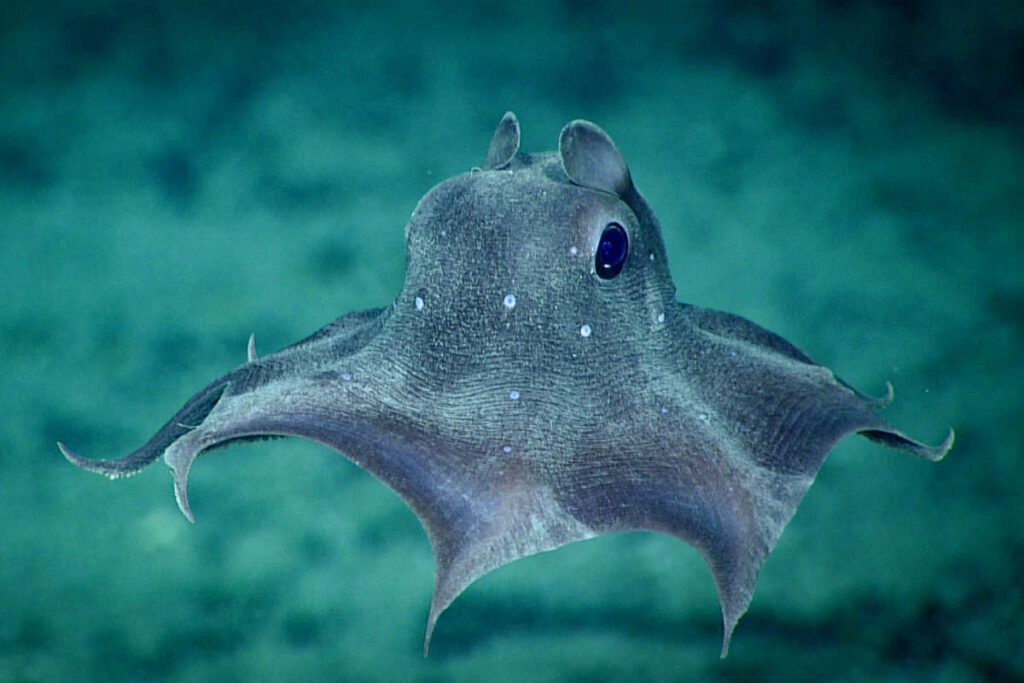
Octopuses are otherworldly on their own, but then there are also species like Dumbo octopuses that are strange even by octopus standards. Unlike other octopuses, these animals swim with their elephant ear-like fins, don’t have ink sacs, live in extreme depths, and more.
18. Greater Sage-grouse

The greater sage-grouse is the largest species of grouse in North America. The males have a very unique look, their pointy tail feathers for one, and more importantly, their two yellow breast sacks that inflate during courtship.
19. Colugo (Flying Lemur)

When it comes to flying, well, technically, gliding mammals, the flying squirrels might be the most famous ones, but it’s the colugo that makes the most impressive glides.
20. The Brazilian Treehopper

The Brazilian treehopper has the most unusual appendage on its head. It isn’t known why they have this appendage or what its function is. However, it is likely they serve to deter predators.
21. Venus Girdle Sea Jelly

Comb jellies are a fascinating phylum of animals with many unique animals. They come in all shapes and sizes, many very similar to jellyfish. One of the most fascinating species is the venus girdle sea jelly, which looks like long transparent ribbons.
22. Hoatzin or Stinky Bird

This bird might not look strange at first glance, but its common name, the stinky bird, might hint at why this one is unique. Its digestive system is somewhat similar to the digestive system of mammalian ruminants (like cows). Food fermentation in their digestive system gives these birds a foul odor.
Still not sure if these are on of the weirdest animals in the world? These birds are also born with claws on their wings, they are the only living bird with functional claws on their wings.
23. Mudskipper Fish

These fish have an unusual body shape and a tendency to go on about on land. Not very fish-like.
24. Saiga Antelopes

These antelopes have a very prominent feature: a pair of closely spaced, bloated nostrils, aka a long downfacing nose.
25. Bald Uakari Monkeys

Not the most well-known monkey in the world, the bald Uakari is, without a doubt, one of the strangest ones. These monkeys have bald red faces.
26. King Vulture

King vultures are the most stylish vultures out there.
27. Spider-tailed Horned Viper

If you dislike spiders and snakes, the spider-tailed horned viper might just be the animal of your worst nightmares. This viper has a tail that resembles a spider.
28. Greater Prarie Chicken

GregTheBusker, CC BY 2.0
Male greater prairie chickens posses possess oval un-feathered neck patches which they can inflate.
29. American Paddlefish
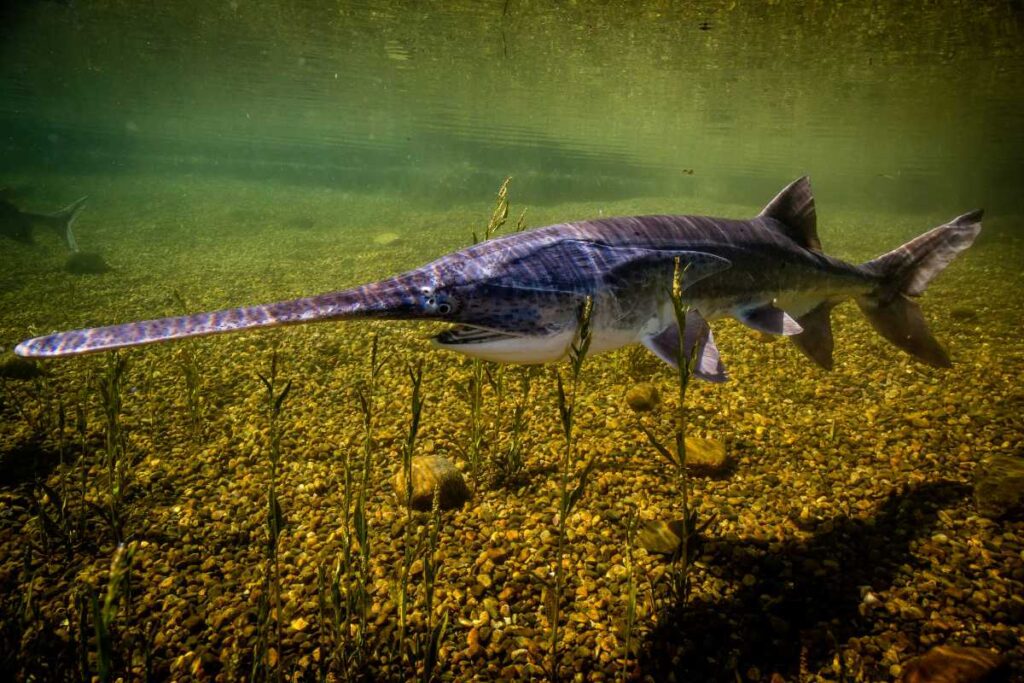
The American paddlefish is unique a unique-looking fish. It has a long, paddle-shaped snout, which is covered in sensory receptors that detect zooplankton. It is also one of the largest freshwater fish in North America and is considered a living fossil, as it has remained relatively unchanged for millions of years.
30. Man-faced stink bug

There are many strange insects out there, but few have as interesting markings as the Man-faced stink bug (Catacanthus Catacanths), which looks like a man with a cool hairstyle.
31. Atlantic Wolffish

This fish is unique for its fierce appearance, with a large head, strong jaws, and prominent sharp teeth. It also has a special adaptation in its throat that allows it to crush hard-shelled prey, such as crabs and shellfish.
32. Gharial

You know crocodiles, and you know about alligators, but have you ever heard about gharials? These crocodilians have a long, narrow snout, which is adapted for catching fish in fast-moving rivers. It is also one of the largest crocodilians and has a distinctive bulge on the tip of its snout, called a ghara (a word that means a mud pot), which is used for vocalizing during mating season.
33. Honduran White Bat
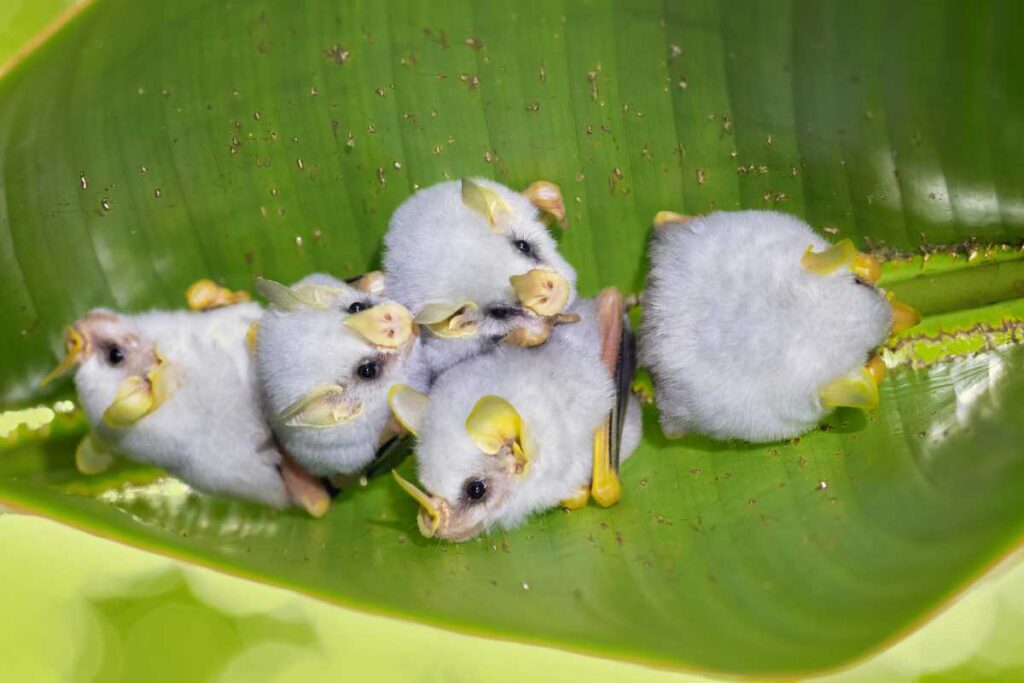
Bats are usually dark brown or grey, but not Honduran white bats. This species of bat has snow-white fur and a wonderful yellow nose, ears, and limbs. Super cute!
34. Nautilus

The nautilus is a remarkable animal not only for its beautiful spiral shell, which is made up of a series of gas-filled chambers that the animal can fill or empty to control its buoyancy, but also because it is considered a living fossil. This animal has remained virtually unchanged for over 500 million years, making it a valuable species for studying the evolution of marine life.
35. Amazon River Dolphin

There are many species of dolphins, each unique in its own way, some more than others. The Amazon river dolphin is one of the strangest ones, though, as it is a freshwater dolphin, and it turns pink as it ages.
36. Mouse Deer

It is a super miniature deer. Out of 10 living mouse deer species, the Java mouse deer is the smallest, with adults being only 12 inch / 30 cm tall on average.
37. Sea Dragons

Sea dragons are known for their flamboyant appearance, with elaborate leaf-like appendages on their bodies that help them blend into their environment. They are closely related to sea horses, and like the sea horse, the sea dragon males carry the eggs and give birth to the young.
38. Slow Loris

Lorises are truly oddballs. Not only are they goofy looking with their large, forward-facing eyes, which provide them with excellent night vision, but they also have a special gland on the inner side of their elbows that produces a toxin. So these sweet-looking animals have a toxic bite and are the only venomous primate.
39. Amazon Royal Flycatcher

With a distinctive crest of feathers on its head that it can raise or lower depending on its mood, the Amazon royal flycatcher is a bird that stands out. It is also known for its elaborate courtship displays, where it spreads its crest and tail feathers to impress potential mates.
40. Thorn Bug

The thorn bug, also known as the treehopper, is unique for its body shape that mimics thorns and other plant structures to avoid detection by predators. It uses its highly modified exoskeleton to create these shapes, which can be highly detailed and realistic.
41. Proboscis Monkey

The proboscis monkey has a distinctive unusually large nose, which can grow up over four inches / ten centimeters in length, and hangs over its mouth. The larger the nose, the louder the vocalization of these monkeys is. Females prefer louder males, so the bigger the nose, the better.
42. Wobbegong Sharks

This is not your typical shark. Wobbegong sharks have exceptional camouflage, with a flattened body and a carpet-like pattern that allows them to blend in with the ocean floor. They are also ambush predators, using their camouflaged appearance to lie in wait for prey to come within striking distance. They are found in shallow waters around Australia and Indonesia.
43. Silky Chicken

These chickens are stunning. Their feathers look more like fur than they do like the feathers of other birds.
44. Pig-Nosed Turtle

There are two things that set the pig-nosed turtle apart from other freshwater turtles. For one, it has a peculiar nose which, as the name of this species suggests, looks like the nose of a pig. Unlike other freshwater turtles, the pig-nosed turtle has fins instead of feet, something usually seen in sea turtles.
45. Aye-Aye

These unusual primates can only be found in Madagascar. Aye-ayes are pretty weird looking on their own, but there’s more; they have an eerie long finger on their front paws, and they have six fingers.
46. Garden Eels

It’s easy to mistake these eels for seagrass. Garden eels are special in that they spend most of their lives half-burrowed in the sand, with only a part of their sticking out, swaying in the current like blades of grass. They are capable of swimming but prefer this seagrass-like existence.
47. Tibetan Sand Fox

Their bulky builds make this type of fox really stand out.
48. Madagascar Leaf-Nosed Snake

The Madagascar leaf-nosed snake is unique in that it has a flattened, leaf-shaped snout that it uses to detect prey. It’s also highly adaptable, with a diet that includes insects, lizards, and other snakes. It’s often active during the day and can climb trees using its sharp claws and a prehensile tail.
49. Yellow Boxfish

The yellow boxfish, as well as many other boxfish, are unusual in that they have a cube-shaped body, which is rare in the animal kingdom. Some boxfish also release a toxic substance when stressed, which can harm other fish near them, so it’s best to avoid them on their bad day.
50. Creatonotos Gangis

Creatonotos Gangis is a top contender for the weirdest animal in the world and is an insect that can look like it has flown straight out of a nightmare. The males of this species have four long, flexible coremata (hairy structures) that they can inflate and display during courtship. Not for the faint of heart.
51. Secretary Bird

The secretary bird is unique in that it has unusually long, powerful legs that it uses to stomp in tall vegetation to flush out its prey. It also has a cool hairdo.
52. Okapi

The okapi looks like a cross between a giraffe and a zebra but is actually more closely related to the giraffe. It has a long, prehensile tongue that it uses to strip leaves from trees and stripes on its hindquarters that help it blend into the forest.
53. Bobbit Worm

The bobbit worm is a predatory worm with sharp, powerful jaws that it uses to capture prey, including fish and other invertebrates. It can grow up to 10 feet / 3 meters long and lives in underwater burrows.
54. Dasymutilla Gloriosa
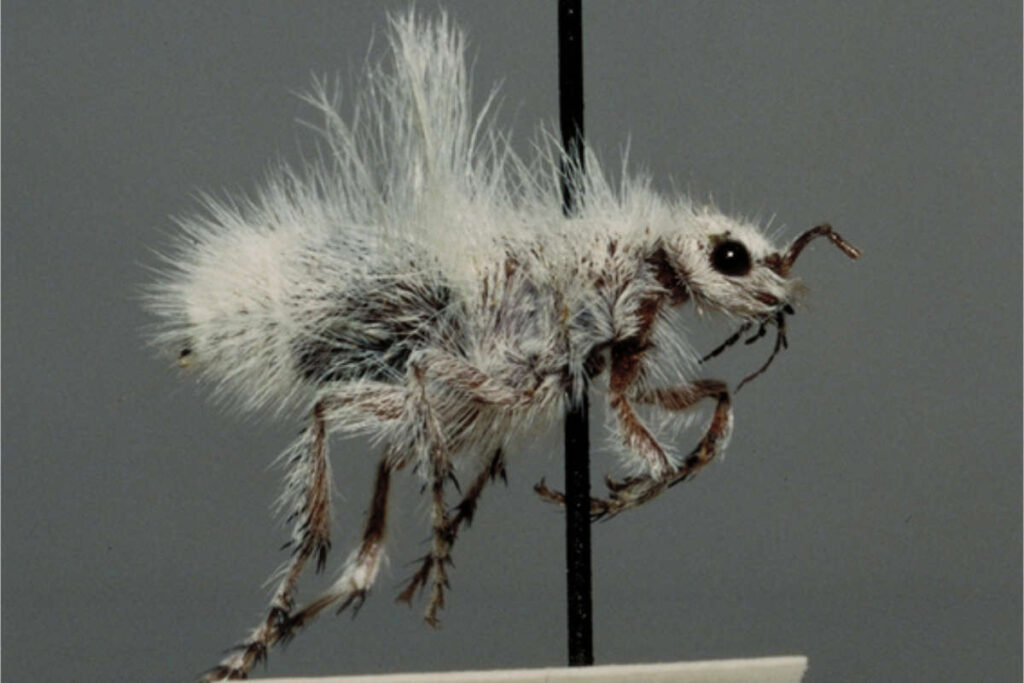
Who doesn’t like fluffy little insects? This insect, also known as the cow killer ant, is actually a species of wasp, not an ant.
55. Fried Egg Jellyfish
Jellyfish can be scary looking, but some can even look appetizing; fried egg jellyfish, for example, looks just like fried eggs.
56. Planthopper

At first glance, these animals look like they have parasites on them or a nasty infection. But what you are seeing is a naturally developed adaptation (wax filaments) that helps these animals avoid detection by predators.
57. Proteus anguinus Olm

If you think axolotls are unusual, you are going to love this animal species. Proteus anguinus, also known as the olm, is a completely aquatic cave-dwelling salamander. Now let’s get to the more fascinating stuff, it can live for up to 100 years, it’s blind, and it has a long, thin body with feathery gills. It’s also known for its ability to survive without food for months or even years. Could this be one of the weirdest animals in the world? We think it is a top contender.
58. Aardvark

They look like an anteater, a pig, and a kangaroo thrown together into one, but aardvarks aren’t closely related to any of those. They are the only living species of the order Tubulidentata, an order of mammals.
59. Dead Leaf Butterfly

Butterflies are usually colorful and stand out, but not the dead leaf butterfly. This butterfly has evolved to look like a dead, shriveled leaf, complete with veins and a stem-like tail. It’s a master of camouflage and can blend in with its surroundings to avoid predators.
60. Amazon Leaffish
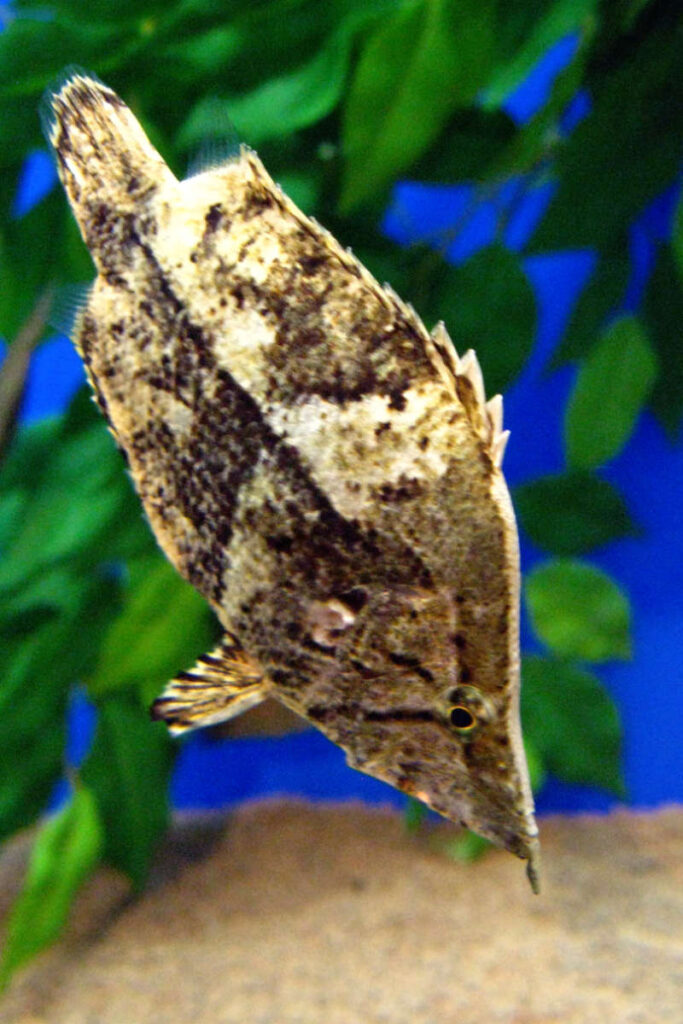
Another animal that mimics a dead leaf is the Amazon leaffish. It is a master of camouflage, able to blend in perfectly with its surroundings thanks to its leaf-like appearance.
61. Satanic Leaf-Tailed Gecko

This gecko has the most menacing name. The Satanic leaf-tailed gecko is another animal that is able to blend in almost perfectly with its environment, thanks to its leaf-like appearance.
62. Swimming Sea Cucumber

The swimming sea cucumber is a deep sea species of sea cucumber unique in that it’s one of the few species of sea cucumber that’s able to swim using its modified tube feet.
63. Golden tortoise beetle

Why be a regular-looking bug when you can be a fancy golden bug.
64. Shoebill

A prehistoric-looking bird with a beak that looks like a shoe. To make things even more impressive, this bird is rather tall, with a typical height range of 43 to 55 in / 110 to 140 cm and some reaching as much as 60 in 152 cm.
65. Hummingbird-Hawk Moth

The hummingbird-hawk moth has evolved to mimic the appearance and behavior of a hummingbird, despite being a moth. It’s able to hover in mid-air while feeding on nectar and has a long proboscis that it uses to suck up the sweet liquid.
66. Dougong

Dugongs are one of only four living species of the order Sirenia, which are animals that are most likely responsible for the birth of myths about mermaids. These sea animals are more closely related to elephants than they are to any other sea mammal, such as dolphins and whales.
67. Barelleye fish

The barreleye fish is a deep-sea fish that has a transparent, fluid-filled head that allows it to see in all directions as its eyes are located inside this transparent dome. The eyes are upward-facing most of the time and are used to detect the silhouettes of prey above them. This fish can rotate the eyes to be forward facing as well.
68. Star-Nosed Mole

The star-nosed mole’s nose is covered with 22 fleshy, pink tentacle-like appendages that are used for sensory perception, which sets these moles apart from other mole species.
69. Armadillo

Mammals with armor. Not many of those to be found.
70. Fainting Goat

They might not look like one of the weirdest animals in the world, but they have a trait that puts them on this list. As their name suggests, the fainting goats have a pretty unique reaction to stress. This breed of goats has a myotonia congenita, a hereditary condition that can cause the animal to stiffen or fall over when excited or startled.
71. Red Weaver-ant Mimicking Jumper
The Red Weaver-ant Mimicking Jumper is a species of spider that is known for its unique behavior of mimicking the appearance and behavior of red weaver ants. These spiders mimic the red weaver ants to avoid being eaten by predators, as these ants are quite aggressive and have a bad taste.
72. Lamprey

Lampreys are primitive, eel-like fish that are unique for their sucker-like mouth and jawless structure. They latch to other fish and feed by rasping a hole through the fish’s skin and sucking its blood.
73. Pangolin

Pangolins are unique mammals known for their protective keratin scales, which cover their bodies like armor.
74. Blue-Footed Booby

The Blue-footed Booby is a seabird known for its bright blue webbed feet, which are used to attract mates during courtship displays.
75. Silkworm Moth
Who doesn’t love a moth that looks like a fluffy plush toy?
76. Maned Wolf
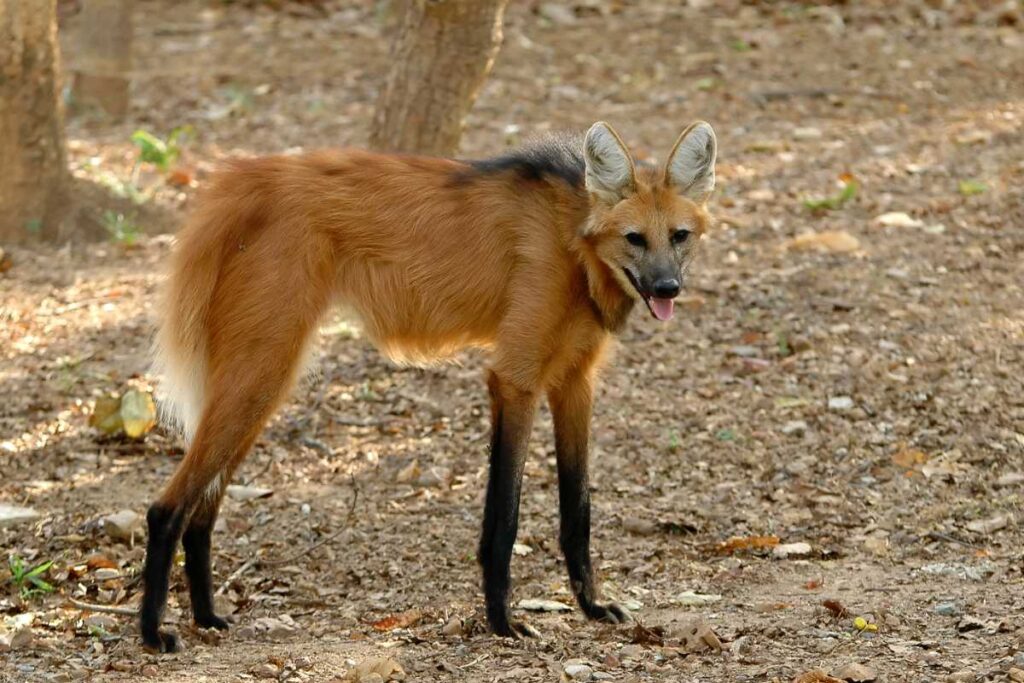
The Maned Wolf is a canid native to South America known for its unique physical characteristics, including long, slender legs, reddish fur, and a black mane. Despite its name, it is not a wolf but is part of its own genus.
77. Japanese spider crab

The Japanese spider crab is a crab with an impressive size. Aleg span that can reach up to 12 feet / 3.7 m, making it the arthropod with the largest leg span in the world.
78. Black Rain Frog

This grumpy-looking frog has a fun defense mechanism. When it is threatened, it inflates it can inflate its body (up to seven times its size), making it look more menacing and harder to catch or swallow.
79. Long Wattled Umbrellabirds

Umbrellabirds are known for their distinctive, umbrella-shaped crest of feathers and their long, pendulous wattle that hangs from their neck.
80. Honeypot Ant

Honeypot ants are unusual ant species that store food in their bodies to feed other members of their colony during times of scarcity. Some workers’ abdomens become so enlarged that they are unable to move, and they hang from the ceiling of the nest like living storage jars.
81. Hairy Frogfish

The hairy frogfish is a unique species of fish for its “hairy” body. It is also able to “walk” on its fins and can change its color over the course of a few weeks to blend with its surroundings, making it a highly effective ambush predator. They are amongst the most unusual looking animals in the sea.
82. Bat-Eared Fox

The bat-eared fox is a small fox species native to Africa that is special for its large ears, which it uses to locate insects and small mammals in the ground.
83. Tentacled Snake

The Tentacled Snake is a species of aquatic snake found in Southeast Asia that is unique for its two long, slender pair of “tentacles” on its snout. It is the only known snake with this feature.
84. Flounder Fish

A fish with both eyes on one side of the body? Why not!
85. Sphynx cat

The Sphynx cat is a breed of cat known for its lack of fur, which is due to a natural genetic mutation.
86. Spiny Stone King Crab

The Spiny Stone King Crab is a species of crab known for its sharp, spiky exoskeleton, which provides protection from predators.
87. Anteater

With their long snouts and tongues, which they use to feed on ants and termites, anteaters are one of the most unique-looking mammals. They lack teeth and instead use their sticky tongue to extract insects from their nests. They are also skilled diggers and can quickly excavate ant and termite mounds using their sharp claws.
88. Giraffe Weevil

The Giraffe Weevil is an unusual species of beetle found in Southern Africa, India, south-east Asia that is known for its long neck structure, which is longer in males than females. They use this structure for combat and to build nests, and the male’s snout can be up two to three times the length of its body.
89. Panacanthus cuspidatus

These bush crickets are characterized by their spike-covered bodies, which serve a camouflage purpose. With their spiked bodies, these insects are able to blend in very well with the grass and other vegetation. Another proper contender for the top spots of weirdest animals in the world.
90. Naked Mole rat

Rats, in general, don’t have the best reputation; this species of rats doesn’t really help that either.
91. Jacob sheep

Where is the fun in having a single pair of horns? Jacob sheep most commonly have two pairs of horns (four horns) but can have just one pair (two horns) or even three pairs (six horns) as well.
92. Gorgonian Pygmy Seahorse

The Gorgonian Pygmy Seahorse is fascinating because of its incredible ability to blend in with the vibrant colors and textures of its host gorgonian coral, providing it with a natural camouflage. It’s also one of the smallest seahorse species.
93. Frilled Lizard

The Frilled Lizard has a distinctive frill of skin around its neck that it can flare out to appear larger and more intimidating to predators. It’s also able to run on its hind legs and some are capable of changing color a bit to blend into their surroundings.
94. Narwhal

Narwhals are the unicorns of the sea. They have long, spiral tusks that grow from their upper jaws, which are actually elongated canine teeth. Of all the sea mammals these are the strangest animals in the world.
95. Saddleback Caterpillar

This caterpillar has a striking appearance, with a green body adorned with a distinctive brown “saddle” marking that resembles a horse’s saddle. However, as is usually the case in nature when it comes to colorful creatures, it is also covered in venomous spines that can cause severe pain, inflammation, and other symptoms if touched, making it dangerous insect to handle.
96. Blue Crayfish

The Blue Crayfish is unique for its bright blue coloration, which is caused by a genetic mutation that affects the pigmentation of its exoskeleton.
97. Gerenuk

The gerenuk wins the competition for an antelope with the longest neck.
98. Angler fish

These fish have a remarkable hunting method: they use a long, protruding spine on their heads to lure prey towards their huge, fang-filled mouths. They are also notable for their bizarre mating behavior, where the much smaller male fuses with the female and essentially becomes a parasite, providing sperm and nutrients.
99. Sloth
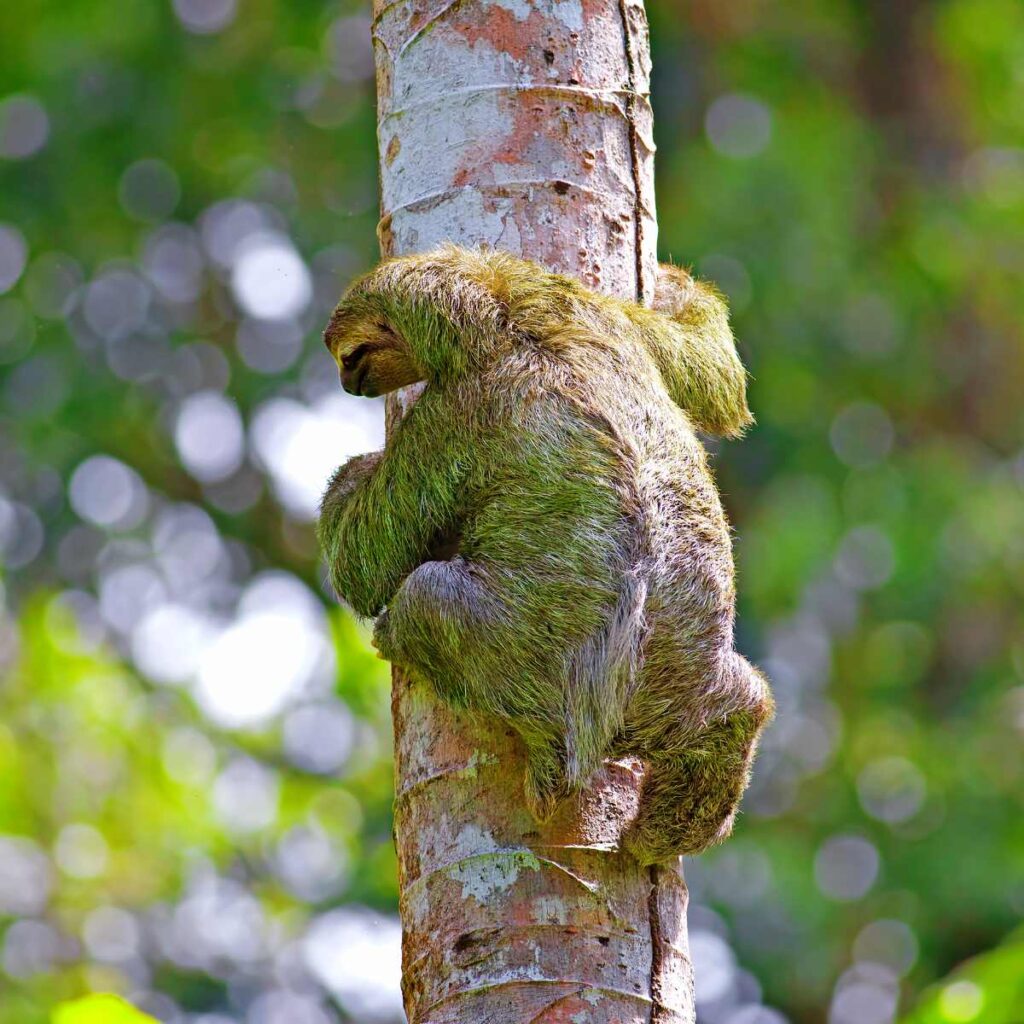
Sloths are the slowest-moving mammals. Their fur can also be covered with algae and moss.
100. Sea Sponges

Last but not least on this list of weirdest animals in the world are the sea sponges. These animals reproduce in a manner more similar to plants than animals, and more oddly, sea sponges don’t have any organs.



